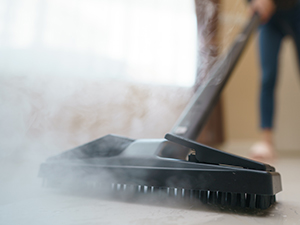
Are Steam Cleaners Safe For Natural Stone?
There are many wrong ways to clean natural stone, which is why we recommend leaving heavy cleaning to an experienced stone restoration professional. As you will see in the following article from Fred M. Hueston, Chief Technical Director for Surface Care PROS and natural stone troubleshooting expert, steam cleaning should be used with care and sparingly, or better yet, not at all…
I am often asked, “Can I use a steam cleaner on my natural stone floors?” Steam cleaning is a very effective way to remove soil and containments without harsh chemicals. However, on marble, granite, and other natural stone, steam cleaning can be harmful. Steam causes thermal expansion and contraction of the stone. This heating and cooling process can create all sorts of problems.
Spalling
Steam cleaning can cause a condition known as spalling. Since most stone is porous, the high temperature of steam cleaning can cause pressure within the stone, which can lead to pitting and/or flaking of the surface of the stone.
Sealer Removal
Natural stone sealers inhibit staining. Impregnating sealers penetrate the surface of the stone. Color enhancing impregnating sealers intensify the colors in natural stone. Topical sealers form a strippable or permanent coating that covers the surface of stone. If natural stone is sealed, steam cleaning can remove the sealer.
Accelerated Crack Damage
As natural stone is fabricated, transported, and installed, stress on the material can cause cracks to form. Stone may also be cracked after installation because of accidental damage or environmental stresses. If natural stone has any cracks, the heat and pressure from a steam cleaner can cause the cracks to expand and open up, making the cracks more obvious and problematic.
Grout Damage
Grout can also be negatively impacted by continuous use of steam cleaning. Damage may include discoloration and the grout cracking and falling apart. Steam cleaning may also remove sealers that were applied to the grout.
Iron Oxidation
If the composition of your natural stone includes iron, steam cleaning poses a risk of discoloration. Moisture reacts with the iron, creating rust-like stains on and in the stone. Iron oxidation discoloration can be extremely difficult or even impossible to remove.
Filler Damage
If your stone has fillers (travertine, for example), steam cleaning can cause the fillers to pop loose and fall out.
Residential vs Commercial Steam Cleaners
Home-type steam cleaners may be safe to sparingly use on natural stone, since these steam cleaners do not reach the same high temperatures as commercial steam cleaners. The maximum temperature of residential steam cleaners is about 250 degrees F, whereas commercial steam cleaners can reach temperature of over 300 degrees F. However, even home-type steam cleaners should not be used often. Steam cleaning every few days, or even every week or two can result in damage. At most, you could use a lower temperature mop-style steam cleaner a few times per year.
Types of Steam Cleaners
There are several types of steam cleaners.
Vapor steam cleaners look like a canister vacuum. They emit a fog of steam vapor to the surface with a wand. The temperature can reach over 200 degrees F.
Steam mops inject steam into a cloth mop. Generally these are safer to use on natural stone than other types of steam cleaners, since the temperature is lower.
Handheld steam cleaners are simple to use and are good for spot cleanup. Using them on stone countertops or shower walls can result in the same type of damage as steam cleaners used on natural stone floors.
To be on the safe side, my recommendation is that you use a pH-neutral, stone-safe cleaner for routine cleaning of your natural stone, and ask your stone restoration professional to take care of any intensive cleaning, as needed.
This article is one of a series of articles written and published on behalf of Surface Care PRO Partners.

